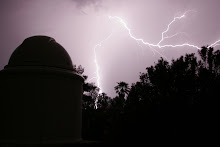Here I am at the Texas Star Party TSP 2006. So far all is going well. My observing buddy Larry and I left on Saturday at about 6 p.m., picked up the motor home at my folks and drove East for about 10 hours total. I was already tired from an early morning rise on Saturday to go run a 5K race with Pam, but we wanted to make sure to arrive early enough to get a decent site for the scopes.
We stopped and got about 3 hours of sleep at a rest stop, then continued on. The final part of the drive goes right by McDonald Observatory, and is quite scenic as it travels through mountains and valleys. We didn't arrive until about 3 p.m. on Sunday afternoon (it's 2 hours ahead in time from Tucson) and there were already tons of people here. After a quick setup of the motor home we drive up to the upper field and found a decent spot to set up. It was a lot of work to get set up, and by the time we finished it was meal time. A good portion of pot roast was a nice reward for what was already a long day.
A few other chores and I finally got a much-needed shower, then worked on cutting a red screen for the laptop out of a big acrylic sheet that Larry had. Before we knew it, the 9 p.m. "no drive" cutoff had arrived and it was time to start observing. It took a while to get the eyepieces and accessories ready, then I polar aligned. I was so pleased to see clear skies since the weather reports have been predicting clouds. It was also quite nice in terms of temperature and humidity, and just a very light hint of a breeze - almost perfect observing conditions, for the observer anyway. However, the sky was not as transparent as I would have liked and the seeing was not too good either.
Unfortunately the internet access was not working (and as of the time I write this, 10:15 Monday a.m., it still isn't up), although the TSP staff had set up wireless access points in the field.
I spent most of the night doing miscellaneous observing and working on finding objects on the TSP observing program lists, specifically the TSP Binocular Observing Program and the "Eye On The Sky" program. Using the 12" Meade LX200GPS, a pair of 6.5x44 binoculars, and a pair of 15x70 binoculars, I observed the following objects:
-Polaris
-Capella
-Caldwell 10 (the Horseshoe Cluster), NGC 663
-M44 Beehive Cluster
-Saturn
-Omega Centauri (Caldwell 80) NGC 5139
-Alphecca (alpha Cor Bor)
-Comet 73P/Schwassmann-Wachmann Fragments C and B
-Acubens (alpha Can)
-M67 open cluster NGC 2682
-M3 Globular cluster NGC 5272
-M5 globular cluster NGC 5904
-Jupiter
-M13 Hercules Cluster NGC 6205
-Arcturus (alpha Boo)
-Centaurus A (Caldwell 77) spiral galaxy NGC 5128
-NGC 5460 open cluster
-Yed Prior (delta Oph)
-M12 globular cluster NGC 6218
-M10 globular cluster NGC 6254
-NGC 5286 globular cluster
-Vega (alpha Lyrae)
-M92 globular cluster NGC 6341
-M4 globular cluster NGC 6121
-IC 4406 planetary nebula
At about 2:45 a.m., the sky had become so cloudy and murky that we decided to pack it up. There were hundreds of other telescopes already covered up so we were near the last die-hards to give it up.
Sunday, February 7, 2010
Subscribe to:
Post Comments (Atom)

No comments:
Post a Comment